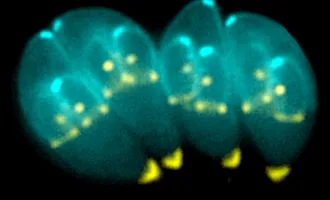Journal Club: Neuroscience and Cell Biology
NEUROSCIENCE: Light evokes melanopsin-dependent vocalization and neural activation associated with aversive experience in neonatal mice. Delwig, A.; Logan, A.M.; Copenhagen, D.R.; Ahn, A.H. PLoS One. 7(9):e43787.
Like cats and dogs, mice are born blind — even at day 6, they have no functional cones or rods in the forming retina, and it typically takes about 10 days postnatally before the eyes can even open. Despite having apparently nonfunctional eyes, very young mice still respond negatively to light with sound and movement. In this paper, researchers characterized the neural response to light in young neonatal mice by exposing them to light and then examining patterns of activation in the brain.
After exposure, the researchers saw activation in the central amygdala and the posterior thalamic group, both regions of the brain involved in pain processing. However, they did not see activation in the trigeminal nucleus caudalis, which is involved in acute mechanical pain. They conclude that the mice’s response to light was similar to a stressful and uncomfortable cue but not similar to an acutely painful cue (as in an injury).
NEUROSCIENCE: The dual orexin/hypocretin receptor antagonist, almorexant, in the ventral tegmental area attenuates ethanol self-administration. Srinivasan, S. et al. (Bartlett). PLoS One. 7(9):e44726.
Almorexant is a drug that binds to orexin/hypocretin receptors present on neurons and prevents calcium mobilization, thereby preventing signal transduction in the neuron and keeping it quiet. Because of this, it had been aggressively pursued by pharmaceutical companies as a potential treatment for insomnia until recently, when it was abandoned, due to unfavorable side-effects. The orexin/hypocretin system has also been implicated in the reward pathway, and researchers here wanted to determine the effects of almorexant on reward instead of sleep. To do this, they administered almorexant to rats and quantified the rate of self-administration of ethanol or sucrose. Interestingly, they found that almorexant significantly reduced ethanol and sucrose self-administration and that this activity could be localized to the intra-ventral tegmental area. The authors suggest that almorexant may be useful as a therapy for alcohol-use disorders.
NEUROSCIENCE: Human P301L-mutant Tau expression in mouse entorhinal-hippocampal network causes Tau aggregation and presynaptic pathology but no cognitive deficits. Harris, J.A. et al. (Mucke). PLoS One. (9):e45881.
Autopsies of patients with Alzheimer’s have revealed some standard changes in the brain that are thought to correlate with disease severity: neurofibrillary tangles that are made primarily of tau protein, and senile plaques made up of Aβ peptides. These tangles and plaques remodel parts of the brain and result in disruption of the brain’s normal neuronal patterning — and it is thought that these structures therefore cause the characteristic decline in cognitive function. However, because of the difficulty in getting specimens of human brain for sampling, there is no way to prove that the tangles and plaques cause Alzheimer’s symptoms without using an appropriate animal model. Here, researchers developed a mouse model that overexpresses mutant human tau protein in a way that mimics the pathology seen in autopsies of Alzheimer’s patients. Interestingly, while they saw the typical Alzheimer-like aggregation of tau fibrils, there was no cognitive defect — meaning that in this model, tau protein accumulation alone does not lead to the cognitive decline seen in Alzheimer’s.
CELL BIOLOGY: Bmi1 is required for hepatic progenitor cell expansion and liver tumor development. Fan, L. et al. (Chen). PLoS One. 7(9):e46472.
Bmi1 is a transcriptional repressor (meaning that it decreases transcription of certain specific genes) involved in stem cell regeneration and when mutated, contributes to the development of multiple forms of cancer. Here, researchers examined the role of Bmi1 in oval cells, a population of liver cells with regenerative capacity. They also examined how Bmi1 is involved in liver cancer when mutated. In a mouse genetically lacking Bmi1, the researchers found less oval cell expansion and a slower rate of cancer development in vivo. When they also deleted the genes that Bmi1 represses, the rate of oval cell expansion was rescued.<boosted? restored?> Given its role in cancer development, the authors suggest that Bmi1 may be an attractive target for cancer therapies.
NEUROSCIENCE: Arf4 determines dentate gyrus-mediated pattern separation by regulating dendritic spine development. Jain, S. et al. (Huang). PLoS One. 7(9):e46340.The hippocampus is the part of the brain where we store and access memories. The dentate gyrus is a part of the hippocampus that helps us distinguish between similar memories, but how it allows us to perform this task is poorly understood. In this paper, researchers describe an Arf4 knockout mouse that cannot distinguish between similar memories. In a test where the mice are placed in a slightly altered, new maze after being habituated to an old maze, these mice have difficulty realizing that they are in a new maze. In the brains of these mice, the researchers saw less dendritic spine development in the dentate gyrus — meaning that the neurons in the dentate gyrus have less capacity to respond to input from other neurons. Arf4 overexpression enhanced dendritic spine density in the dentate gyrus in both wild-type and an Alzheimer’s-like mouse model, indicating that altering expression of this gene may influence memory function.


